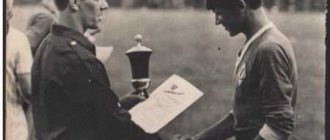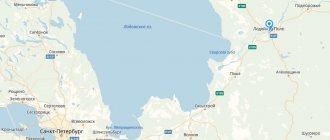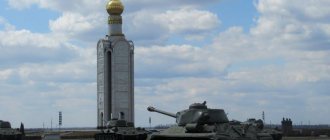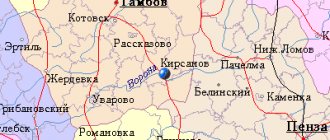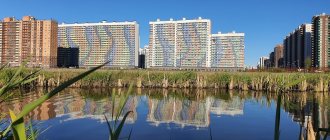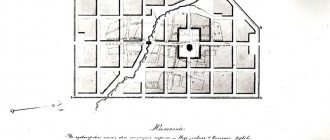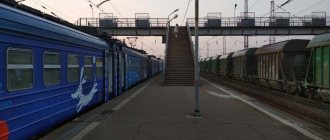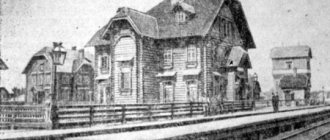Podporozhye
Settlement in the 16th – 19th centuries
The village of Podporozhye was first mentioned in the Scribe Book of 1563. The settlement was founded on the Svir River and received its name from the nearby river rapids. At that distant time, the river played an important role in these parts, being the most reliable transport route. Passing the largest rapids Sigovets and Medvedets on the Svir River was a responsible matter and required a certain skill. And often the teams of merchant ships and ushkui were forced to turn to local residents for help. The significance of the Svir rapids was also reflected in the modern coat of arms of the city of Podporozhye, approved in 2010, in which the bear symbolizes the Medvedets rapids, the whitefish in its teeth is the Sigovets rapids, three squares along which the bear climbs also point to the rapids, symbolizing the name of the city - Podporozhye.
The Svir River has always played an important role in the development of the city. At the beginning of the 18th century, Emperor Peter I, by his decree, resettled the peasants of the Borovichi district of the Novgorod province, who hunted on the Msta River and were skilled pilots, to guide ships through the rapids. In addition to ensuring the safe passage of ships along the river, peasants had to harvest and float ship timber for the construction of the Russian fleet. In order to provide additional assistance for the passage of ships along the river bed, a towpath (a road for towing by barge haulers) was built along its bank in 1810. Since 1867, towing of ships along the entire river was carried out by steamships, and since 1875, on the section of the river near Podporozhye, a tuyer (chain steamer) was used as a tugboat.
In the List of populated places of the Olonets province for 1879 (according to information from 1873), the village is listed as Podporozhye Nizhneye Olonets district. During this period, the village had 18 households, in which there were 106 residents of both sexes - 55 males and 51 females. In February 1877, the first one-class zemstvo school, transferred from the Yandeb parish, opened in the village. On June 14, 1881, the Podporozhye Model School was opened.
Podporozhye in the 20th century
According to the List of populated places of the Olonets province for 1905, in Podporozhye, Vazhinsky volost, Olonetsky district, there were 26 peasant houses, the number of the peasant population was 174 people - 82 men and 92 women in 29 families. The non-peasant population was 10 people - 4 men and 6 women (1 family), living in 2 houses. For the entire village there were 17 horses, 51 cows and 74 heads of other livestock. There was a postal station in the village.
In 1914–1916 construction of a section of the Murmansk railway passing through the territory of the future Podporozhsky district was carried out, this became an incentive for the further development of the settlement.
During the reform of 1927–1929. The provinces were abolished. On August 1, 1927, the Northwestern region was renamed Leningradskaya, within which the Podporozhye district was formed. In 1929, the Podporozhets collective farm was formed. In September 1931, the Podporozhye timber industry enterprise was created. At the same time, the newspaper “Svirskie Ogni” began to be published. But the 1930s were overshadowed by a period of political repression in the Podporozhye region, from which not only the local population suffered. Camps for the repressed were built in these parts. In 1932–1933 in one of these camps, in the Vazhinsky branch of Svirlag, Alexey Fedorovich Losev served his sentence.
In 1933, Podporozhye was the center of the Podporozhye village council, which included six settlements with a population of 1,675 people. Until the mid-1930s. there was no school corresponding to the population size in the village. The school that existed at that time could not accommodate all the children; it was very small. In 1936, two new schools were founded in Podporozhye: in Pogre - a school named after. A. M. Gorky and in Sotsgorodok - a school named after. A. S. Pushkin. It was planned to erect both buildings within 2 years. But by the autumn of the same 1936, the builders put the school building in Pogre into operation. It was erected in just 4 months in the absence of any equipment. The Gorky School became the first stone building in Podporozhye.
In 1936, the construction of the Verkhnesvirskaya hydroelectric power station began, which was later interrupted by the war, and the layout of the village was developed. The design of the building was carried out according to the project of the architect Konstantin Isaevich Rosenstein. The scale of construction of the power plant required workers; people from different parts of the country flocked to the village, which led to rapid population growth. By a resolution of the Presidium of the All-Russian Central Executive Committee of July 5, 1937, the village of Podporozhye received the status of a workers' village. On September 1, 1937, School No. 1 opened its doors. A. S. Pushkin, which became the successor to the zemstvo school, founded back in 1877.
In 1938, the regional center was moved from the village of Vazhiny to the working village of Podporozhye. In the same year, the building of a kindergarten-nursery was put into operation, which later housed an orphanage and a teacher training school. In July 1938, Solomon Abramovich Fried arrived in the village, who played a significant role in the construction of the Verkhne-Svirskaya hydroelectric power station.
Village during the war
During the Great Patriotic War, the village of Podporozhye found itself in enemy-occupied territory. Already on September 16, 1941, Finnish troops entered the village. Even before the Red Army retreated, work was underway in Podporozhye to organize partisan detachments that were supposed to conduct sabotage activities behind enemy lines. The first Podporozhye partisan detachment, consisting of 31 people, was created on July 30, 1941. Before the occupation, from August 15, 1941, a hospital with 900 beds operated in the village, which was stationed here for 22 days. In the fight against the fascist invaders, many natives of Podporozhye and the Podporozhye region gave their lives, including partisans M.A. Kukkoeva, A.M. Lisitsyna and others.
On January 27, 1944, the blockade of Leningrad was completely lifted. During the Svir-Petrozavodsk offensive operation of the Soviet troops, carried out from June 21 to August 9, 1944, the 18th Infantry Mginskaya Red Banner, Orders of Suvorov, Kutuzov division of Major General M. Absalyamov (7th Separate Army of Lieutenant General A. N. Krutikova, Karelian Front under the command of Army General Kirill Afanasyevich Meretskov) the resistance of the Finnish army units was broken. At about 8 o'clock on June 22, 1944, the regional center of the Leningrad region, the workers' village of Podporozhye, was liberated. Until July 24, the Podporozhye region was completely liberated from the Nazi invaders.
Post-war time
In July 1944, the Podporozhye district council was restored. In October 1944, the central regional library in Podporozhye began operating. On January 22, 1945, an evening school opened in the village. On November 28, 1948, vocational school No. 19 opened its doors. In November 1951, the Podporozhye Children's Library opened.
In the post-war years, a number of large industrial enterprises appeared in the village. In 1951, the first unit of the Verkhnesvirskaya hydroelectric power station was launched, and in 1953, the construction of the power plant was completely completed.
June 28, 1956 By decree of the Presidium of the Supreme Soviet of the RSFSR, the workers' village of Podporozhye was transformed into a city of regional subordination.
At the end of March 1957, a plant for reinforced concrete bridge structures was put into operation, the construction of which began in the spring of 1955. In July of the same year, asphalting of city roads began. On July 1, 1958, the Podporozhye Wood Processing Plant (now Verkhne-Svirsky Timber Industry Enterprise) began production. In 1959–1969 The Alley of Heroes was being built in the city, for which a beautiful place was chosen overlooking the power plant. In 1959, the first bust of Valeria Gnarovskaya was installed on the alley; 8 years later, three more busts of Heroes appeared here on high pedestals.
In 1959, a dairy plant was put into operation in Podporozhye. In 1961–1963 With the participation of pioneers, Komsomol members, and pedagogical school students, a birch grove was planted in the city according to the design of the architect A. Rogov. In 1962, Podporozhye radio broadcasting was founded (nanny radio "Prisvirye"). On November 11, 1963, the House of Pioneers opened in the city of Podporozhye, the first director of which was Nikiforova Margarita Nikolaevna. In 1964, the Podporozhye House of Culture opened its doors, and in December 1966, the Podporozhye Puppet Theater (today it is the Exemplary Puppet Theater). December 19, 1967 was the first day of operation of the city history and local history museum. In the same year, the Podporozhye repeater with a radio mast 184 meters high was put into operation.
In September 1972, the Podporozhye Youth Sports School was created. In September 1974, a new building was commissioned to house the Podporozhye regional hospital. In December 1975, an automatic telephone exchange came into operation.
In 2001, its own television “Televes” began broadcasting in Podporozhye.
On June 28, 2014, in the city of Podporozhye, in the park near school No. 8, a monument to the “Mothers of War” was inaugurated. The installation of the monument was timed to coincide with City Day, as well as the 70th anniversary of the liberation of the city from the Nazi invaders.
Administrative and municipal status[edit]
As part of its administrative divisions, Podporozhye serves as the administrative center of Podporozhye District. [1] Administratively, it, together with thirteen rural settlements, is included in the Podporozhsky district as the municipal formation “
Podporozhye Settlement”
.
[1] As a municipal division, Podporozhsky municipal settlements are included in the Podporozhsky municipal district as the Podporozhsky urban settlement
. [5]
Economics [edit]
Industry[edit]
Gateway of the Verkhne-Svirskaya hydroelectric power station
In Podporozhye there are enterprises of both the construction and food industries. [12] Verkhnesvirskaya hydroelectric power station is located in Podporozhye.
Transport[edit]
The railway connecting St. Petersburg and Murmansk passes through Podporozhye.
An asphalt road passes through Podporozhye, connecting Lodeynoye Pole with Vytegra in the Vologda region. There are also local roads.
The Svir River is navigable and is part of the Volga-Baltic Waterway, connecting the Volga and Neva river basins. The waterway is regularly used by cruise and cargo services.
Links[edit]
Notes[edit]
- ^ abcdefgh Area Law No. 32-oz.
- ^ abcdef “Archival copy” Podporozhsky district (August 1927 - February 1963, January 1965) (in Russian). System of classifiers of executive bodies of state power of St. Petersburg. Archived from the original on March 10, 2014. Retrieved March 10, 2014.CS1 maint: archived copy as title (link)
- ^ a b Federal State Statistics Service (2011). “All-Russian Population Census 2010. Volume 1" [All-Russian Population Census 2010, vol. 1]. All-Russian Population Census 2010 [All-Russian Population Census 2010]
. Federal State Statistics Service. - "26. The size of the permanent population of the Russian Federation by municipalities as of January 1, 2021". Federal State Statistics Service. Retrieved January 23, 2021.
- ^ abcde Law No. 51-oz.
- "On the Calculation of Time". Official Internet portal of legal information
. June 3, 2011. Retrieved January 19, 2021. - Post office. Information and computing center of OASU RPO. ( Post office
).
Search for postal service objects ( postal Search for objects
) (in Russian) - ↑
Federal State Statistics Service of Russia (May 21, 2004).
“The population of Russia, the constituent entities of the Russian Federation as part of federal districts, urban settlements, settlements, settlements is 3 thousand or more people” [Population of Russia, its federal districts, federal districts, districts Urban settlements, rural settlements - administrative centers and rural settlements with a population of over 3,000] (XLS). All-Russian Population Census 2002
. - “All-Union Population Census of 1989. The actual population of the union and autonomous republics, autonomous regions and districts, territories, negative phenomena, urban settlements and villages. Archival copy” Lodeynopolsky district (in Russian). System of classifiers of executive bodies of state power of St. Petersburg. Archived from the original on December 28, 2013. Retrieved March 11, 2014.CS1 maint: archived copy as title (link)
- Information on the socio-economic situation for the 1st half of 2012 (in Russian). Administration of the municipal district "Podporozhsky municipal district of the Leningrad region". Retrieved November 24, 2012.[ permanent dead link
] - Monuments of history and culture of the peoples of the Russian Federation (in Russian). Ministry of Culture of Russia. Retrieved June 2, 2016.
- Podporozhye Museum of Local Lore (in Russian). Russian Cultural Heritage Network. Retrieved November 27, 2012.
